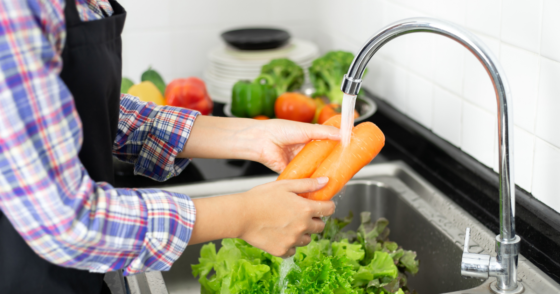
The warnings continue to rain. In a study published last week, UFC-Que Choisir denounced the contamination of 50% of fruit and vegetables from intensive farming by high-risk pesticides. Again this week: the NGO Génération Futures reports that 63.1% of non-organic fruits, vegetables and grains contain pesticide residues above the detection limit. As you will have understood, it is therefore better to buy organic. But what to do if you do not have the resources or the offer is limited in your territory? Are we doomed to ingest harmful substances with every cherry or carrot that is ingested? In reality, it is possible to reduce trace amounts of pesticides with a few tricks. Overview.
#1 Remove the skin
Peeling is certainly the most radical alternative to trying to get rid of pesticides. By removing the skins from your fruit and vegetables and then washing them with water, you can indeed reduce pesticide residues by half, Michel Cymès estimates on RTL. However, it is impossible to completely remove these harmful substances, even by peeling your plants.
But if this technique is effective, it also has a downside: some nutrients are found in the skins of fruits and vegetables. So if you peel them, you’re robbing them of their vitamins and other benefits…
#2 A bath with water and baking soda
If you don’t want to remove the skin from your fruits and vegetables, proper washing is a must! Rinsing your plants with cold water is not enough to remove the pesticide residue that is present in their skin. Instead, opt for extended soaking. To do this, prepare a bath with two glasses of water mixed with two teaspoons of baking soda. Submerge your plants in it and let them soak for about 15 minutes.
Once this time has passed, rinse your fruits and vegetables one more time with cold water and you’re done. This solution is less effective than peeling, but it still reduces the amount of pesticide residue present, according to a study published in the Journal of Agricultural and Food Chemistry (note, this study only studied two pesticides). [1]
#3 Vinegar Dip
To clean your fruits and vegetables, you can also use an essential household product: vinegar. Whether white or cider, vinegar will help you eliminate the bacteria in your plants and can also reduce the presence of pesticide residues (even if no scientific research proves it).
Dilute a glass of vinegar in two liters of water and soak your fruits and vegetables in it for about 15 minutes. Then rinse them with cold water and dry them with a clean cloth. You can eat them afterwards, without having to remove the skin! [2]
#4 Organic, if possible
Some fruits and vegetables may not withstand a water bath. This is the case, for example, with small berries or raspberries, which fill up quickly and lose their flavour. For these foods, it is therefore preferable to buy organic, as organic farming prohibits the use of synthetic pesticides. In general, the UFC-Que Chsoisir recommends consuming organic fruits and vegetables to maintain your health. “But it is unacceptable to force consumers to switch to a more expensive offer when these troubling global findings are the result of a particularly lax regulatory framework”denounces the association in its latest report on the subject.
As you will have understood, there is no miracle solution to get rid of pesticides that are harmful to health. But while you wait for their ban, you can still perform these fortified washes to continue eating fruits and vegetables essential to a healthy diet.